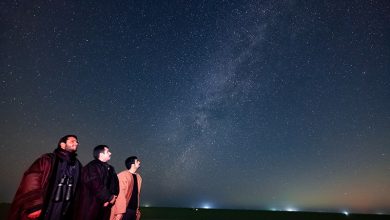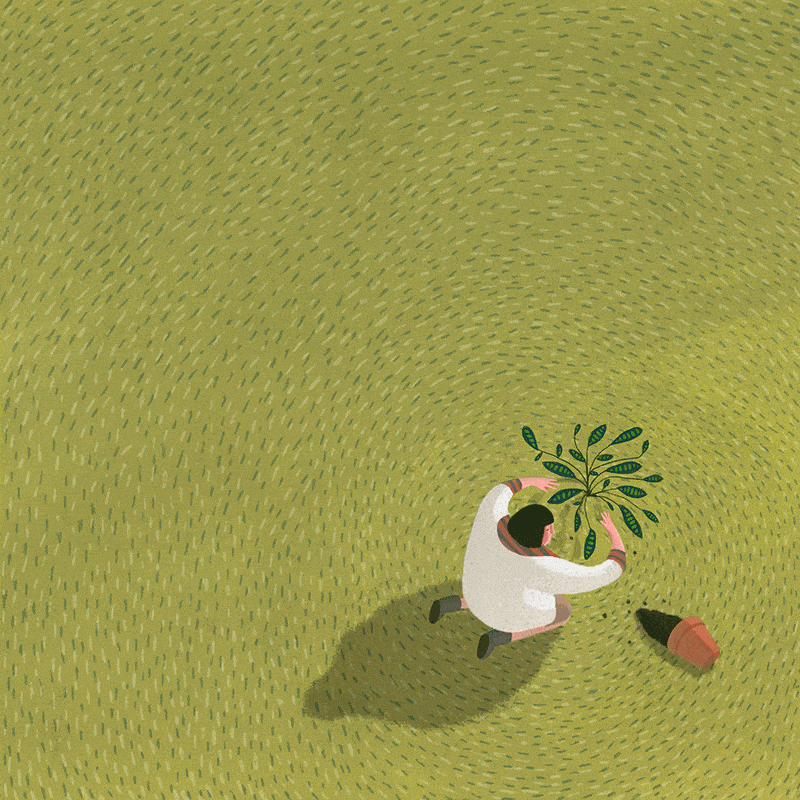Mangrove sensing from space
Forest exploration and rehabilitation of affected areas

Dr. Waheed Mohamed Mofaddal
is an expert in the Regional
Zone for the Protection of the Marine Environment and a researcher at the National Institute of Oceanography and Fisheries (Egypt)
Mangrove is not just an ordinary salt-resistant plant, which grows and grows on the coasts of the salty seas and oceans in the tropics and subtropics in freshness and growth, but it is a unique habitat and an integrated ecosystem, whose importance and benefits are magnified by the many advantages and services it provides to humans or marine and coastal organisms that live in it and feed on its countless bounties, nutrients and environmental resources. This plant has multiple environmental and economic benefits and unique medicinal and pharmaceutical benefits. This plant, also known in the Arab region by other names such as mangroves, kandal and aika – is considered a natural incubator for fish, crustaceans and other marine organisms, due to the density of its trees, the richness of the surrounding soil in organic matter and the availability of natural protection factor. Mangrove forests, with their lush and intertwined trees totaling about 250,000 square kilometres worldwide, are full of thousands of species of fish, birds and other creatures, which would not exist and come together in a single living environment without the rich sources of food and natural protection provided by this habitat.
Mangrove forests are one of the most important habitats of blue carbon due to the ability of their roots to absorb excess carbon from the atmosphere and store it in the soil, and they are at least 6 to 8 times superior to rainforests, so they contribute effectively to mitigating the effects of climate change.
Mangrove Aykat plays an important role in stabilizing marine soils and protecting beaches from erosion and erosion due to their large aerial roots and their spread over large areas near soft clay coasts. Mangrove aikat is also a natural buffer against wave gusts and other marine factors, because it reduces the height and strength of incoming waves by up to 66%.
In addition, mangrove forests effectively support the local economy due to their role in supporting beach, kayak and ecotourism tourism, and in increasing the productivity of fish farming operations. For example, the financial returns from the mangrove forests in Florida alone are estimated at about one billion dollars a year.
Of course, the rehabilitation of the affected areas and the protection of this generous habitat from the growing pressures and negative influences require regular follow-up and study of its condition by scientific methods, whether in the field or from space. Remote sensing and space monitoring technology in general has provided a major and unparalleled advantage in such cases, as it is possible to monitor the health status of plants and track time changes in their sprawling trees and forests accurately and continuously over more than one period of time, thus helping to monitor changes in this vital habitat and manage it realistically and properly. This is difficult to achieve through traditional examination methods and field visits, due to the difficulty of reaching some areas, the extension of mangroves over huge areas in most sites, and the high material cost required to perform these surveys and complete the analyzes and the rest of the field and laboratory work necessary to complete the study.
Despite all these benefits, mangrove forests worldwide have been subjected to great pressure and many negative practices that have greatly affected them, leading to their decline and stunting in some areas, and even the deduction or disappearance of large areas in others. Efforts to rehabilitate degraded areas or cultivate mangroves have recently increased in some new areas, leading to a new increase in area and development in some countries, particularly the UAE, Saudi Arabia and Egypt. In Kuwait, the Kuwait Institute for Scientific Research and the Environment Public Authority are making unremitting efforts to cultivate mangroves in several areas in the north of the country, especially the Jahra Reserve and the northern part of Bubiyan Island.
Of course, the rehabilitation of the affected areas and the protection of this generous habitat from the growing pressures and negative influences require regular follow-up and study of its condition by scientific methods, whether in the field or from space. Remote sensing and space monitoring technology in general has provided a major and unparalleled advantage in such cases, as it is possible to monitor the health status of plants and track time changes in their sprawling trees and forests accurately and continuously over more than one period of time, thus helping to monitor changes in this vital habitat and manage it realistically and properly. This is difficult to achieve through traditional examination methods and field visits, due to the difficulty of reaching some areas, the extension of mangroves over huge areas in most sites, and the high material cost required to perform these surveys and complete the analyzes and the rest of the field and laboratory work necessary to complete the study.
Advantages of remote
sensing technology Making remote sensing technology available for civilian use and launching space sensors dedicated to scientific research and exploration of the Earth for nearly 50 years, with the data and images captured in a chronological and historical archive that can be consulted at any time, have led to a semblance of revolution in the way we study and explore the planet's natural and biological wealth and systems, not just the mangrove forests.
Researchers studying Mangroves have benefited from this revolution in many ways, as it has become easier to monitor the state of this and other habitats on a regular basis using satellite imagery. It has also become possible to determine the type of changes that have occurred in it, the causes and factors that led to this change, and whether they are the result of human interventions, development activities or some natural factors, from the fact that satellite images taken at different times are compared to each other.
If we talk about remote sensing systems, at the present time there are tens or even hundreds of types of sensors or remote sensors carried either on space satellites or on planes, orbiting around us in space or the air that visualize the Earth's surface, coastal areas, seas and oceans at night and at the edges of the day. These sensors each have specific capabilities and capabilities, and each of them was launched to observe certain elements and components on the Earth's surface, whether plant or other, in a specific and known area of the electromagnetic spectrum, regularly and periodically.
As such, there are sensors and remote sensors for exploring the land and the topography of the earth, and the manifestations on it from natural resources or plants and forests, including, of course, the Qurum and other plants, and there are other sensors for the study of marine bodies and habitats only, and a third specialized in studying the atmosphere and the weather, and so on.
This diversity has helped to monitor mangrove forests with more than one space sensor, and to monitor them in more than one way in more than one period of time in the past and present, which contributed to the increase in the number of studies applied to this habitat, and to the development of more than one technique and method for sensing and studying this plant in detail.
Remote sensing can also take panoramic images of the study area and the targets and ground elements it contains, whether it is a habitat for Mangroves or otherwise, and this is a major advantage that cannot be achieved in any other way, as through the captured images all these elements can be seen in a holistic view, and even studied and examined all at the same time, which helps to link causes to variables, and thus facilitates the identification of factors of change.
In addition, some remote sensing systems, such as radar, are characterized by their ability to take satellite images and collect information on ground elements in all weather conditions, which means that a habitat such as Mangrove can be studied at all times and conditions, which cannot be applied or achieved, for example, in the case of field work that requires stable weather conditions and the absence of sea storms to ensure safety and security.
Mangrove trees look out of space
It is known that all healthy foliage and succulent plants, including mangrove leaves, contain green pigments or chlorophyll in large quantities within their leaves, and these chromosomes are responsible for photosynthesis and other plant biological processes. For remote sensing systems, these chromosomes strongly absorb electromagnetic radiation in the visible blue and red light space, while reflecting these rays in the visible green space. This is precisely why healthy mangrove plants appear in real-color aerial or satellite photographs in a bright green color, where green pigments absorb blue and red colors and reflect green, and the difference in color tone is due to the difference in the age and species of trees.
For example, if a plant is exposed to wilting, a lesion or a fungal disease, such as brown rust, the percentage of green pigments in the leaves of the plant usually decreases, and with it the absorption of blue and red colors. Therefore, the plant in this case appears in satellite images in a yellow color (which is the color that mixes between red and green), pink or dark brown color, depending on the severity of the plant being affected by the disease. Based on this, it is possible, through satellite visuals and by measuring what is known as the "vegetation index" in it, to distinguish and identify plants and agricultural areas affected by fungal diseases or whose leaves have been yellowed or falling, from healthy and prosperous plants.
As for the mangrove plant, it is characterized by its high greenness coefficient, due to the freshness of its leaves, its high spectral footprint, and the ability of its leaves and the rest of its components to reflect electromagnetic rays, especially green rays located in the visible light space. This, on the other hand, greatly facilitates the process of identifying and monitoring it through satellite images, compared to other plants. In the case of high-resolution spatial satellite visuals and images, in addition to the distinctive color and spectral imprint of mangroves, these trees can also be distinguished from their distinctive pyramidal shape, and from the presence of many air roots around the trees.
However, the most remarkable feature of this plant, at least in terms of growth pattern, is its spread in the form of extended ikat and dense forests over sprawling areas along the shores, or at the ends of dry valleys with clayey soil that flows into the seas, although some also grow in lush shrubs that sometimes overlap deep into coastal waters. Therefore, they can be easily distinguished by satellite images due to their growth in the form of green belts and stripes and their presence usually near beaches and muddy areas confined between the tidal zone.
Distinct
The quality of the soil and the study of vegetation cover in general are among the most important applications of remote sensing technology in agriculture, as it is possible through this technique and through satellite images, to estimate the area of spread of a particular type of plant or agricultural crop and the extent of its expansion in an area, and it is also possible to monitor and track the amount of areas that have been degraded or that have been deducted during a specific period of time, and determine the health status of the plant by measuring the extent of the greenness of the plant. Using this technique, it is also possible to draw quantitative and qualitative maps of areas acquired with a crop or plant such as mangroves, and to determine their density and degree of freshness, and the quality of facilities, installations and human activities nearby.
Accordingly, the methods of studying mangrove forests by remote sensing technology and using satellite images vary between interpreting and describing these forests and describing the surrounding or close to them directly elements and formations, taking notes in the form of a quick and general descriptive report, or developing direct mapping of plant areas and tree positions in the study area, and then producing modern thematic maps showing the areas of extension of the Mangrove Ikat and the extent of their spread in that area.
It is also possible to study mangrove forests and collect information about them and halophytes located near them or overlapping with them by conducting a classification of plant species located in that area, whether this classification is under the direct supervision and guidance of the competent researcher, which in this case is known as directed or supervisory classification Supervised Classification, or it was automated, that is, relying entirely on the program for the analysis and classification of satellite images, which in this case is known as unsupervised classification.
The Geographic Information System (GIS) and remote sensing technology outputs can also be used to create an integrated database on mangrove areas and their condition and type of changes, and can also be used together to determine suitable places for plant cultivation and tree growth in available coastal locations.
As such, remote sensing technology can play an important role in the exploration of mangrove forest areas, in assessing their condition and monitoring the negative factors affecting them, and can help rehabilitate areas that have been degraded, which ultimately benefits many other sectors and beneficiaries.




